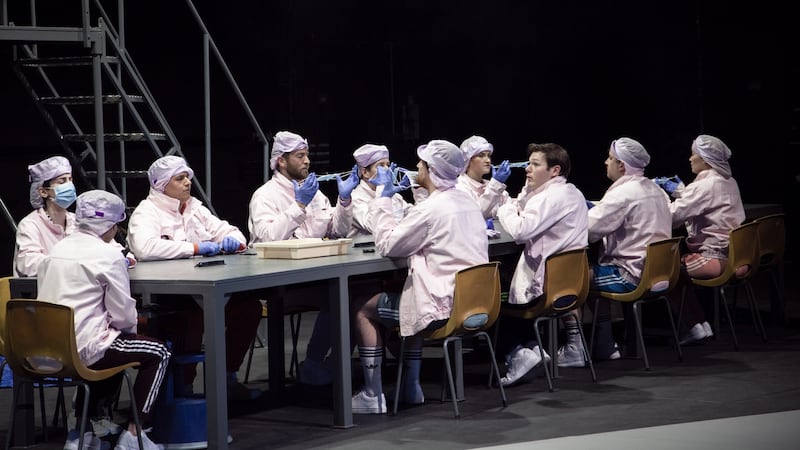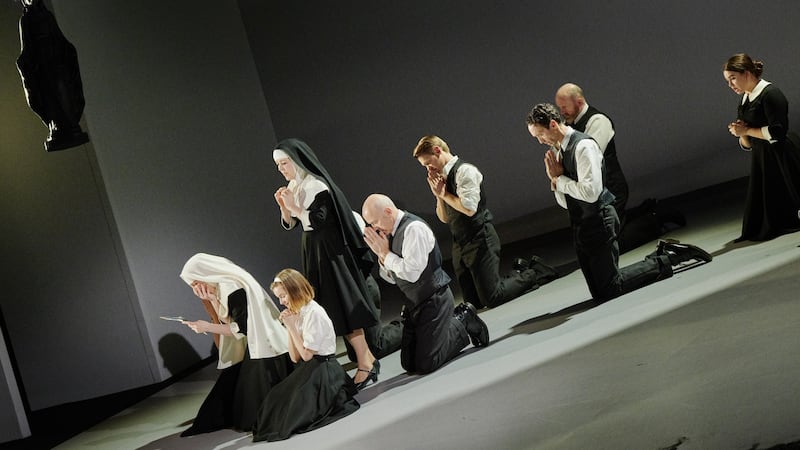On January 7th, a letter to Minister for Culture Josepha Madigan, signed by 311 – now 425 – theatre actors, directors, designers, technicians and producers, protested about the effects of a large increase in co-productions, and a reduction in self-produced plays, at the Abbey Theatre under its co-directors Neil Murray and Graham McLaren. This, they wrote, had led to reduced job opportunities and pay rates, with knock-on effects across the theatre sector.
Now, almost a year later, the signatories again wrote to the Minister – joined by a separate letter from The Irish Writers’ Guild – saying the Abbey’s actions responding to their concern don’t live up to commitments made during discussions.
What has happened in the intervening time? Fairly quickly after the initial letter, the national theatre committed to increasing its percentage of in-house productions and to paying in-house rates to those working on co-productions; more recently the role of casting director was reinstated. There was a marathon session of the Oireachtas Joint Committee on Culture, Heritage and the Gaeltacht, sectoral meetings between the Abbey and theatre workers, meetings with the Arts Council and the Abbey board. The theatre reported to the Minister on May 2nd, detailing 17 planned actions and commitments in response to the letter of concern. It culminated in two formal meetings, on June 5th and July 9th, with independent facilitator Aibhlín McCrann, between Abbey management and representatives of the 426 theatre professionals, paid for jointly by the Abbey and theatre workers’ crowdfunding.
For several months, there were delays, and disagreement over the final report, with the Abbey taking specific issue with the minutes of the discussions.
At the end of November, the facilitator made a call, as she was empowered to do, on the minutes. They comprise a 42-page detailed document spanning a range of topics, with input from both sides and discussion framed around the Abbey’s 17 actions (ranging from major issues to small details) outlined to the Minister in May.
The minutes, which have been seen by The Irish Times, summarise points and use quotes, usually not specifying the speaker. They were circulated to the signatories and to Abbey management; the signatories this week shared them with the Minister, Arts Council and Abbey board.
No consensus
Judging by the document, it appears there was progress, but no consensus on some issues. The parties discussed the lack of opportunities for freelance Ireland-based directors, writers, designers and actors, at the national theatre; to-and-fro about how work is commissioned and how many new plays are actually in train; how auditions are run (actors being asked to prepare much work, “and then not being allowed to go through with it. It’s disrespectful”), and a promise to better handle casting. There was acknowledgement and thanks for commitments on pay parity for co-productions.
Pay increases were also discussed, as was the lack of design facilities at the Abbey, producing work from the Irish theatre canon and whether the Abbey would present shows addressing the centenaries (“There will be work that addresses the centenary”). Signatories queried the lack of Irish-based directors employed and mentioned the non-Ireland-based director for the Christmas show [Cal McCrystal, directing Drama at Inish]. “Is there an inference that there was no Ireland-based director good enough to do this work?” The Abbey responded that McCrystal was well known for physical theatrical comedy – “It’s an artistic choice. No slight was intended.”
Assurances were given by the Abbey that the 2020 programme would address the imbalance: “There will be 9 self-produced shows in 2020. Some may be taken by the in-house director/associate director but not all of them . . . We hope there will be more opportunities for freelance directors.”
Signatories asked about the criteria for remounting shows, which reduced the opportunities for new shows, and “a perception that the only shows being brought back are yours?” [meaning co-director Graham McLaren]. The Abbey said it remounted financially viable shows.
Signatories also queried the lack of shows from the Irish canon. “It’s why this place is famous. We’re trained to act in those types of plays. The style of work we have now does not give actors the opportunities to do the type of work that we are trained for . . . roles that are complex and contradictory, and that reflect the often complex and contradictory lives of the audiences.” The Abbey reassured them there would be work from the canon in 2020, but said its focus was on gender parity. There was difficulty securing rights to plays, too.
Impacts on freelance jobs
Signatories claimed the Abbey, now a “primarily co-production and receiving house with its ensuing double funding”, removes funds from the rest of the country and impacts on freelance jobs and regional arts institutions. But the Abbey said it “primarily presents self-produced work, if you examine the schedule on both stages, week by week”, and said the 2020 programme it was then working on, had a “high emphasis on self-produced work . . . At the moment, we are looking at 9 self-produced shows, 2 co-produced and 2 other shows . . . So, it’s primarily Abbey self-produced work.” It said the 2020 programme would reflect “a lot of the positive developments over the past few months and will also reflect the Abbey Theatre’s move to deliver on what it had set out to do”.

The meetings ended with what reads like an impassioned speech by an Abbey representative about its “desire to work with the sector in an open and transparent way”, saying “there has been a genuine attempt by the national theatre to engage”. This led to a “heated exchange” between a couple of signatories’ representatives and one of the directors (unnamed). The facilitator was disappointed at the “unfortunately robust nature of the engagement, despite agreement that mutual respect would underpin these talks”. She noted participants had spoken with genuine commitment.
Participants agreed that if there was disagreement about content or tone of notes from the meetings, the facilitator, after consultation with both groups, would be the final arbiter. They agreed notes would be circulated by the end of July. That it took until November 29th to do so points to continuing disagreement.
So does the Abbey’s statement to The Irish Times this week that dialogue with signatories concluded in May, following its report to the Minister. It “agreed to take part in two meetings, as requested” afterwards. “It does not believe that the ‘record’ of the two meetings that took place over the summer, as seen by The Irish Times, is an accurate account.”
Wobbles
In the hiatus, there had been wobbles. On the first day of rehearsals for a theatre festival show, Pasolini’s Salò Redubbed, the Abbey said it was not running payroll, contrary to understandings. (The situation was resolved and it did.) Following dismay about the cessation of open Abbey auditions, in early November an invitation to open auditions had a mailing list so wide it appeared to include tens of thousands from general and marketing lists, perplexing actors.
In October, long before the summer meetings’ minutes had been agreed, Minister for Culture Josepha Madigan, on a visit to the theatre, said she was happy with how it had responded to controversies. “I think it has been a real demonstration of collaboration between theatre practitioners, between the Abbey and various other stakeholders and I’m happy to have facilitated that conversation.” It was “an ongoing conversation. It is not something that has an end point at any stage. It is important that there is communication.
Just as the notes were circulated, the Abbey unveiled its 2020 programme. It includes strong shows, but mysteriously the theatre’s suggestion of nine self-produced shows in 2020 had become three new in-house productions: Shelagh Delaney’s 1958 play A Taste of Honey and Joe Dowling directing Brian Friel’s Faith Healer, along with The Boy, a new cycle of plays by Marina Carr. There are three in-house remounts/touring shows.
While there will be a wide and impressive range of shows on Abbey stages and touring, six are co-productions with top Irish and international companies, plus a number of presentations (essentially the use of the hall).

In response to a request for clarification this week, the Abbey said that, during the summer talks, the number of self-produced shows for 2020 had not been finalised, and also that “additional shows for next year’s programme have yet to be announced”. In self-produced shows they included the three remounts/tours of existing work, and point out that The Boy is in two parts, sold as separate productions. It also plans an additional (new) winter production.
The 2020 lineup is set to be McLaren and Murray’s last full-year programme; their five-year term began in July 2016. McLaren is not listed as directing any of the new shows.
‘Gravely worried’
At a meeting on November 30th, signatories said they were “gravely worried” about the programme just announced. “They’re clearly not taking on board any of the issues we have raised or indeed meeting their own voiced commitments,” one attendee said.
The theatre’s 2018 accounts, filed in late October, showed €12.2 million income, including €7million Arts Council funding, and expenditure of €12.34 million. Audiences grew to 127,499 in 2018, the highest box office since 2013, boosted by the West End musical Come From Away and Roddy Doyle’s Two Pints on tour. There was an operating surplus of €30,885; spending of €166,153 on capital and short-term projects resulted in a loss of €135,268 for the year.
There is also some disquiet inside the theatre about gaps in senior management. A 2019 organisation chart, seen by The Irish Times, has a layer of senior management (below co-directors Murray and McLaren) comprising seven roles. Of those, three are believed to be vacant: head of producing (who left to join the Gate Theatre in September); director of strategic engagement and communication (vacant since mid-2018); and a vacant “revenue generation function”. A fourth senior manager, technical director, appointed in February 2018, is leaving at the end of the year. A new director of finance was appointed last summer.
In response, the Abbey this week said the chart is an internal “consultation/evolving document” and it has one senior management vacancy for which it is currently recruiting. “All roles and responsibilities are being considered within the context of our strategic plan.”
As the year draws to a close, and nearing one year from when it erupted, one of the surprising aspects of the latest Abbey controversy is that so many matters are still apparently unresolved.
















